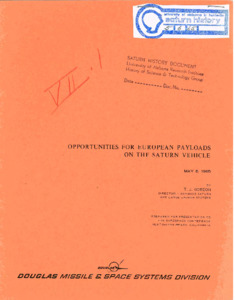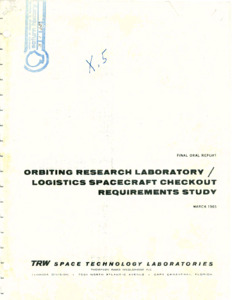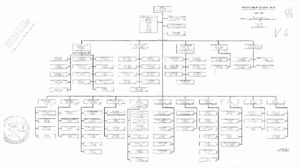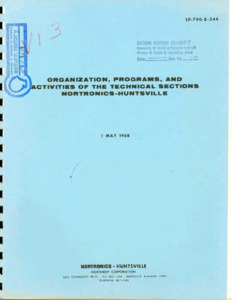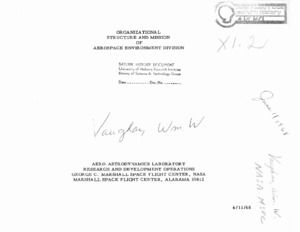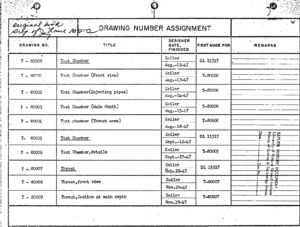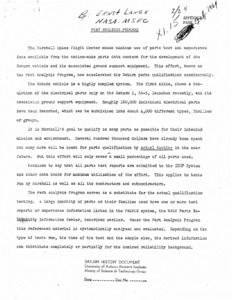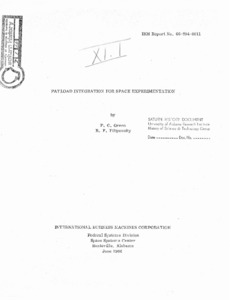
Browse Items (970 total)
Sort by:
-
"Opportunities for European Payloads on the Saturn Vehicle."
Prepared for presentation to the Eurospace Conference. In this paper, we will not deal with the first two questions, which must be of interest to every potential experimenter, but only with the last question of vehicle availability. -
"Orbiting research laboratory/logistics spacecraft checkout requirements study."
This report presents the results of the study of Orbiting Research Laboratory and Logistic Spacecraft Checkout Requirements as they relate to prelaunch operations at MILA. The study was performed jointly by the Florida Division and the Systems Research and Analysis Division of TRW Space Technology Laboratories for NASA under the terms of contract NAS10-1076. -
"Organizational charts for Rocketdyne, a Division of North American Aviation, Inc."
Chart No. 1 Rocketdyne master approved by S. K. Hoffman, President (Vice President, North American Aviation, Inc.,).; Chart No. 6.1 Engineering Field Laboratories approved by R. J. Lodge, Director.; Chart No. 6.1.1 Santa Susana Field Laboratory, approved by D. M. Carpenter, Manager.; Chart No. 6.1.2 Field Laboratories Nevada Field Laboratory approved by G. J. Wunderlin, Manager.; Chart No. 6.1.3 Edwards Field Laboratory approved by F. F. Twight, Manager.; Chart No. 6.6 Engineering Administration approved by P. J. Kanne, manager.; Chart No. 12 Solid Rocket Division approved by T. E. Myers. -
"Organization chart of the Department of Defense - Directory."
An organizational chart directory. -
"Organization of a countdown"
The Organization of a Countdown was developed over 8 years of missiles and space systems testing at the Douglas Aircraft Company, Sacramento test Center. The experience on which this study was based includes the Thor development and acceptance testing, Titan I second stage engine development testing, Development of liquid hydrogen handling techniques, Saturn S-IV and S-IVB development and acceptance testing. The intent of this paper is to examine the static test countdown organization and discuss the need for a systematic method to organize a countdown. -
"Organization, programs, and activities, of the technical sections Nortronics - Huntsville."
This brochure is intended to depict the present status of the technical activities of Nortronics-Huntsville as of the date indicated. It is based on all currently available information. It is subject to periodic revision as additional pertinent information becomes available. -
"Organizational Structure and Mission of Aerospace Environment Division"
This document offers a brief description of the Aerospace Environment Division including the basic mission; branches; an organizational directory; and responsibilities of the Environment Research Office, the Atmospheric Dynamics Branch, the Terrestrial Environment Branch, and the Space Environment Branch. William W. Vaughan's name is inscribed on the front page. -
"Drawing number assignment"
The document is a photocopy of the Drawing Number Assignments from August 1947 to May 1953. Categories include but are not limited to the drawing number, title, designer, and date finished. Inscribed on the front is "original book property of Jay Laue, MSFC." -
"Part analysis program."
Includes carbon copy of letter sent to David L. Christensen from Ernst Lange regarding the Part Analysis program. -
"Payload integration for space experimentation."
Space experimentation requires an increasingly complex planning and systems engineering effort to meet the demand for highest precision and reliability of all measurements and observations. A companion paper discusses the interfaces between the scientific/technical areas of space experimentation and the instruments, subsystems and support systems within the spacecraft. This paper deals with the organization and the procedures which are needed to perform the difficult payload integration process for space experimentation. In the course of this process it is necessary to define the experiments completely, to describe all instruments in terms of engineering specifications, to investigate the commonality of equipment, to group the experiments into mission compatible payloads, to specify acceptable loads on all subsystems and astronauts (when present) and to plan for all contingencies during the flight.
